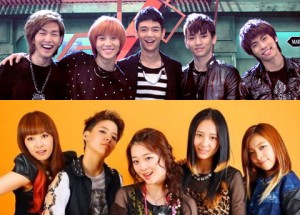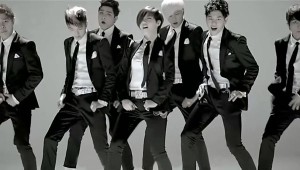 During the course of the year we’ve witnessed female groups do their thing, an expansion in the numbers and popularity of male groups, an unexpected return of the female soloist, the beginnings of a comeback from male soloists, and one other phenomenon which begs to be documented – the emergence of sibling pairs. Many mid-level companies this year have debuted either brother or sister groups as part of a sibling pair – male and female group counterparts who directly resemble or contrast with one another in some shape or form. As is common when debuting a rookie group to link them to an existing group, companies with the privilege of doing so promote their rookie group as a brother or sister group of one of their already established groups.
During the course of the year we’ve witnessed female groups do their thing, an expansion in the numbers and popularity of male groups, an unexpected return of the female soloist, the beginnings of a comeback from male soloists, and one other phenomenon which begs to be documented – the emergence of sibling pairs. Many mid-level companies this year have debuted either brother or sister groups as part of a sibling pair – male and female group counterparts who directly resemble or contrast with one another in some shape or form. As is common when debuting a rookie group to link them to an existing group, companies with the privilege of doing so promote their rookie group as a brother or sister group of one of their already established groups.
A company’s pairing of its prized group with its newly formed group of the opposite gender to create a sibling pair is foundational to the concept of the company family – the idea that all the artists in one company are happily united. There are several marketing benefits that go along with establishing a company family like holding family concerts and releasing family albums, which are covered in more detail here. In light of the family concept, establishing sibling pairs has become a heavy indicator of how well a company is doing in today’s K-pop industry. Let’s observe how management companies have utilized sibling pairs to their advantage.
First, there are a few qualifiers that groups must meet in order to achieve the distinction of being sibling pairs:
- They must be a male and female group from the same company. Unfortunately, there isn’t much of a selling point between sibling groups of the same gender largely because they are usually viewed as occupying a separate niche (eg. Super Junior and Exo) or are mere knock-offs of one another (eg. Beast and BtoB).
- They must be coupled with only one other group. If a company has multiple male and female groups, they are coupled monogamously with one another. There may be multiple sibling pairs within the same company. As we’ll see, SM Entertainment is a good example of how it pairs its different generations of sibling groups.
- They must be planned out and marketed as siblings. For example, Star Empire Entertainment doesn’t do much in pairing its sibling groups. ZE:A may make a likely pairing with either of its sister groups, Nine Muses or Jewelry, yet many do not consider them as sibling pairs because they are hardly ever marketed as a family package. Likewise, Miss $ and Phantom share very similar concepts under Brand New Music but they are not considered sibling pairs perhaps due to their generational difference.
- Lastly, they must uphold some sort of conceptual connection by either having the younger sibling constructed in the image of the older sibling, or by molding the newer sibling as a direct opposite of the original sibling.
 It’s through this last point where sibling groups become clearly distinguishable. There are two ways to design a pair of sibling groups. The less popular way is to recreate the image of the older sibling in the form of the opposite gender, essentially creating a rehash of the original group. Examples of such are evident when observing how closely f(x) resembles SHINee and how 2NE1 tends to mirror Big Bang. This is done when a group has a groundbreaking concept that may be fittingly replicated by the opposite gender.
It’s through this last point where sibling groups become clearly distinguishable. There are two ways to design a pair of sibling groups. The less popular way is to recreate the image of the older sibling in the form of the opposite gender, essentially creating a rehash of the original group. Examples of such are evident when observing how closely f(x) resembles SHINee and how 2NE1 tends to mirror Big Bang. This is done when a group has a groundbreaking concept that may be fittingly replicated by the opposite gender.
SHINee’s experimental contemporary image gained popularity because it deviated from the traditional gender traits of beastly male groups. Their softer, more feminine aesthetics were easily replicable in a female group and so f(x) became a mash-up of quirky cuteness with tomboy aesthetics. Similarly, YG Entertainment brought Big Bang’s hip hop image into the forefront and armed 2NE1 with the same ferocious sound, style, and energy as their older sibling. The varying levels of popularity between f(x) and 2NE1 shows that simply replicating a popular group in the opposite gender doesn’t necessarily guarantee a replication in their success. Although 2NE1 was quite groundbreaking at the time of their inception, it was not because they were known as the female version of Big Bang, but because of the quality of their releases.
 The safer approach towards creating sibling pairs is to stick to traditional gender norms, allowing the feminine appeal of the female group to complement the masculine traits of the male group, or vice versa. These complementary sibling pairs are more prevalent because of the model created by the industry’s most successful companies. SM does a wonderful job at successfully creating complementary sibling pairs from generation to generation. First with H.O.T and S.E.S, then questionably so with TVXQ and CSJH the Grace, and now with Super Junior and SNSD, these complementary sibling pairs have given SM claim to large portions of the market through a good part of the last two decades.
The safer approach towards creating sibling pairs is to stick to traditional gender norms, allowing the feminine appeal of the female group to complement the masculine traits of the male group, or vice versa. These complementary sibling pairs are more prevalent because of the model created by the industry’s most successful companies. SM does a wonderful job at successfully creating complementary sibling pairs from generation to generation. First with H.O.T and S.E.S, then questionably so with TVXQ and CSJH the Grace, and now with Super Junior and SNSD, these complementary sibling pairs have given SM claim to large portions of the market through a good part of the last two decades.
By playing it safe, sticking to what works, and replicating this formula for success from generation to generation, SM has built an empire off Lee Soo-man’s blueprint of cultural technology which unarguably dictates the need for a complementary pairing between the company’s top male and female group in order to fulfill the market’s enormous demand for the solidarity that comes with such a powerhouse pairing. Other companies have caught on to this formula and have since established their own set of complementary sibling pairs.
 Ever since the great girl group explosion erupted in 2009, boy bands have been right on the heels of their female counterparts largely because many male groups were formed as complementary siblings to established female groups. Countering the monopoly that was held by SM’s complementary sibling pairs, JYP Entertainment created 2PM as beastly complements to the girly image of Wonder Girls. At the same time, Cube Entertainment ambitiously debuted the hyper masculine Beast, then proceeded to launch the ultra-feminine 4Minute within the same year.
Ever since the great girl group explosion erupted in 2009, boy bands have been right on the heels of their female counterparts largely because many male groups were formed as complementary siblings to established female groups. Countering the monopoly that was held by SM’s complementary sibling pairs, JYP Entertainment created 2PM as beastly complements to the girly image of Wonder Girls. At the same time, Cube Entertainment ambitiously debuted the hyper masculine Beast, then proceeded to launch the ultra-feminine 4Minute within the same year.
Considering the ongoing success of these established pairings, it’s no wonder that the four biggest companies in today’s industry (not to forget about YG) were also the first to solidify their set of sibling pairs. It’s this competitive edge that many smaller companies wish to emulate. In today’s widely expanding market, establishing a sibling pair is no longer a luxury afforded by only the largest companies, it’s become a necessity in which mid-level companies must undoubtedly strive for in order to stay competitive amongst the heavy sea of competition. If cementing a sibling pair is a true indicator of success, then which of the up and coming companies have taken the largest strides in establishing their own pairs of siblings?
It should be no secret by now that Starship Entertainment and Pledis Entertainment are gradually establishing themselves as heavy hitters in the industry. Initially formed as small agencies promoting just one famed soloist (K.Will and Son Dam-bi, respectively), these two companies vaulted into relevancy through the success of their prized girl groups (Sistar and After School). They have since buffered their roster with complementing brother groups (Boyfriend and NU’EST) and the continued promotion of their established soloists. In essence, they are following the same course of the industry’s top companies in creating a company family.
Outside of the top four management companies mentioned above, Starship and Pledis are the closest to establishing a family concept. Following the blueprint laid out by SM Town, these two have also released holiday albums under their family name. Happy Pledis has already released two such albums while Starship Planet is gearing up to release their second. Although Starship has yet to announce any intentions of holding a family concert, one can suspect that they will soon. Meanwhile, Pledis is rumored to hold their first family concert at the end of the year. FNC Entertainment, which features instrumental idol groups, has also established itself as a force to contend with by planning to hold its first family concert.
 Pledis really stands out for having taken the farthest measures of any mid-level company in possibly delegating sibling pairs for the next generation. Hello Venus debuted this May as a cute and charming counterpart to After School. However, their true purpose may soon be to secede After School as the company’s flagship girl group and to be paired with Tempest, the foreshadowed male group Pledis plans to debut in the near future (with also a classically inspired name). Whether that comes to fruition or not, Lee Soo-man must be horrified impressed that another company has already taken the next step in his approach towards creating successive generations of top-notch sibling pairs. With the high number of sibling pairs manifesting in 2012, the competition is only going to get stiffer.
Pledis really stands out for having taken the farthest measures of any mid-level company in possibly delegating sibling pairs for the next generation. Hello Venus debuted this May as a cute and charming counterpart to After School. However, their true purpose may soon be to secede After School as the company’s flagship girl group and to be paired with Tempest, the foreshadowed male group Pledis plans to debut in the near future (with also a classically inspired name). Whether that comes to fruition or not, Lee Soo-man must be horrified impressed that another company has already taken the next step in his approach towards creating successive generations of top-notch sibling pairs. With the high number of sibling pairs manifesting in 2012, the competition is only going to get stiffer.
Since the emergence of Boyfriend last year, many other brother groups have since been formed by mid-level companies as sibling pairs to their established girl groups. Although Boyfriend and NU’EST don’t occupy the traditional image of beastly masculinity, their success can be credited towards their more experimental style, a liberty afforded to them due to the profitability of their company’s sunbaes. Since they are not at pressure to be highly profitable upon debut, they are free to experiment with different sounds and styles until they find one that works for them. While Boyfriend and NU’EST aren’t perfect masculine complements to their respective sister groups, they provide enough of a masculine contrast to satisfy the void of a male counterpart for Sistar and After School which fans have long waited for.
 In contrast, B.A.P and A-Jax were conceived as the ideal complementary male counterpart for their respective sister groups. With Secret having been the only artist generating the company’s cash intake, TS Entertainment could not afford the luxury of experimenting with their new boy band. Instead, it followed a very tight blueprint to ensure the popularity and profitability of B.A.P. The company’s desperate initiative to make B.A.P a successful venture is evident in how it has overworked the boys through five promoted releases and a reality show in less than a year since their debut. Nevertheless, their ultra-masculine debut concept complemented Secret’s uber-feminine image astonishingly well, albeit their new cutesier image seems more like a male rehash of “Shy Boy.” Likewise, the downfall of DSP Media over the years has led to this critical point where it must establish another male group to replace SS501 as the masculine counterpart to their revenue lifeline, girl group Kara. Designating A-Jax with a “bad boy” image to complement Kara’s current cycle of sexy, DSP reveals that it is willing to test the boundaries of shameless marketing in order to solidify this sibling pair.
In contrast, B.A.P and A-Jax were conceived as the ideal complementary male counterpart for their respective sister groups. With Secret having been the only artist generating the company’s cash intake, TS Entertainment could not afford the luxury of experimenting with their new boy band. Instead, it followed a very tight blueprint to ensure the popularity and profitability of B.A.P. The company’s desperate initiative to make B.A.P a successful venture is evident in how it has overworked the boys through five promoted releases and a reality show in less than a year since their debut. Nevertheless, their ultra-masculine debut concept complemented Secret’s uber-feminine image astonishingly well, albeit their new cutesier image seems more like a male rehash of “Shy Boy.” Likewise, the downfall of DSP Media over the years has led to this critical point where it must establish another male group to replace SS501 as the masculine counterpart to their revenue lifeline, girl group Kara. Designating A-Jax with a “bad boy” image to complement Kara’s current cycle of sexy, DSP reveals that it is willing to test the boundaries of shameless marketing in order to solidify this sibling pair.
In terms of mid-level companies which profit from a single male group, they too have begun forming sister groups to cement a sibling pair. Stardom Entertainment, home to the infamous Block B, debuted EvoL in August as somewhat of a female rehash of their established male group. Fiery, edgy, and quite different from those feminine sister groups, Stardom Entertainment definitely took a page from YG in attempting to create the female version of their hip hop imaged boy band. EvoL can also be considered quite complementary to Block B in that their sexy splendor pairs quite well with Block B’s macho mayhem.
Forming under J. Tune Entertainment, home to MBLAQ, Two X also debuted in August but they went with a more traditional route in terms of their image. Their easy-going girly concept goes down quite well with MBLAQ’s over-emotional angst. A great indicator of how well sibling pairs complement one another is how well their collective personalities would make for a potential romantic coupling. In the case of MBLAQ and Two X, it’s like a match made in heaven.
 Now that most mid-level companies have ingrained in them the mindset of creating sibling groups, forming sibling pairs, and conforming to the family concept in order to rise above the competition, the question remains of what is going to happen to those who have yet to follow suit? There’s been much talk about how poorly Core Contents Media has managed all of their acts, and one thing it has completely botched is having yet to create a sibling pair for its cash queens, T-ara. It has placed all of its focus on creating (and recreating) girl groups who more or less look and sound the same. It has neglected its male groups in Supernova and Speed, completely failing to market them as complementary brother groups to the formerly beloved T-ara. CCM certainly has enough artists and talent to earn itself a spot among the industry’s elite, but its dependency on T-ara, failure to popularize any of its other acts (except for maybe Davichi?), and failure to pair a male counterpart with T-ara has left it in utter shambles.
Now that most mid-level companies have ingrained in them the mindset of creating sibling groups, forming sibling pairs, and conforming to the family concept in order to rise above the competition, the question remains of what is going to happen to those who have yet to follow suit? There’s been much talk about how poorly Core Contents Media has managed all of their acts, and one thing it has completely botched is having yet to create a sibling pair for its cash queens, T-ara. It has placed all of its focus on creating (and recreating) girl groups who more or less look and sound the same. It has neglected its male groups in Supernova and Speed, completely failing to market them as complementary brother groups to the formerly beloved T-ara. CCM certainly has enough artists and talent to earn itself a spot among the industry’s elite, but its dependency on T-ara, failure to popularize any of its other acts (except for maybe Davichi?), and failure to pair a male counterpart with T-ara has left it in utter shambles.
On that note, other questions regarding possible sibling pairings remain. When will we see a sister group for U-Kiss and Infinite? With the ensuing disbandment of Wonder Girls, will JYP focus on forming a complementary brother group for their new generation girl group, miss A? Will YG be seeking a new generation sibling pair with the upcoming debut of their new girl group? Fans of these groups would like to see their respective companies ensure their financial sustainability through coupling them with either a complementary or at least a rehashed sibling. Which potential sibling pair formation would you most want to see happen?
It’s getting to that time of the year where we reminisce about the trends we’ve observed throughout the course of 2012. While there are many catchy labels we can associate with 2012 (year of the boy band, year of the female soloist), let’s not neglect the influx of sibling groups which have formed sibling pairs within mid-level companies. If anything, 2012 may be remembered as the year the pesky younger siblings were conceived. Like with any pair of siblings, there will always be a love-hate relationship between them. Luckily, we are not their parents so we are allowed to have favorites. Which pair of siblings does your bias favor?
(@STARSHIPent, hankyung, hankooki, Images via MBC, SM Entertainment, YG Entertainment, JYP Entertainment, Pledis Entertainment, @Secretimehs, Core Contents Media)


